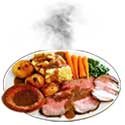The Sunday roast dinner in early 20th century England

Traditionally Sunday dinner (lunch as it is called today) was always a large roast meal with all the trimmings. This page explains why the meat joint was so large, why there were so many vegetables and trimmings and why the meal was always on a Sunday.
____
Extracted from the memoirs of the webmaster's mother (1906-2002) and edited by the webmaster with further research and firsthand contributions from others
Why roast meals were always on Sunday
On Sundays we always had a delicious roast dinner at mid-day. It had to be on one particular day because served with all the trimmings, its left-overs set the framework for the following weekday meals. The particular day was Sunday because Sunday was the day for church services and the population was almost entirely Christian.
The type of meat for the roast
The joint of meat had to be very large indeed by today's standards. You can see why on the weekday meals page. The joint was almost always beef because every other meat was expensive. We did have lamb sometimes, but it did not produce as pleasant tasting dripping, and bread and dripping was a staple meal for children after school during the week. Chicken was expensive for townspeople as battery farming was years away and removing the feathers was an extremely unpleasant task. We did, though, have the occasional wild rabbit which shooting parties shot because they were pests to farmers.
Preparing the Sunday Roast
Progress - if it is progress - has taken a lot out of the roast Sunday dinner of my childhood. In the summer, children would have to shell the peas and help with the other vegetables where they could. The knives were sharp, so we were limited in what we could do until our mothers thought we were old enough to handle sharp knives without hurting ourselves.
There were always lots of vegetables because it was important that enough would be left over for meals during the week. An unforgettable noise was the chopping of mint for mint sauce.
We children also had to top and tail the gooseberries and blackcurrants for the fruit pie. There was always a fruit pie with lashings of fruit to follow the roast. People seemed to eat more in those days.
As well as preparing the roast dinner, my mother always baked a cake for the week. It always seems strange to me, looking back, that people were so fanatical about not doing work on Sunday afternoons, when they worked so hard on Sunday mornings.
The trimmings with the Sunday meal
The Sunday roast was served with all the trimmings.
Yorkshire pudding was served with beef. It was always a large one made in a large pan, then cut into squares for serving. Suet dumplings were served with lamb.
There were roast potatoes and fresh green vegetables in season. Sometimes there were roast parsnips or roast baby beetroots, and the gravy was superb.
The formality of Sunday dinner
The belief that children should be seen and not heard was strictly adhered to at Sunday dinner. I know of men who kept a cane at the table and used it to whack any child who, in his terms, misbehaved. That did not happen in my family - a look from my mother or father was enough!
After Sunday dinner
After the meal we all had to help clear up. Then the rule was absolutely no work. Sunday was supposed to be a day of rest which was interpreted as work hard in the morning, but not in the afternoon or evening. In the evening we all went to church.
If you can add anything to this page or provide a photo, I would be pleased if you would contact me.
Text and images are copyright
sources: early 20th century material
sources: ww2 home front and other material
contact
the webmaster/author/researcher/editor
privacy policy



